|
Music Is The Healing Force Of The Universe The Inconsistency of |
|
|
||||||||||||||||
 |
 |
||||||||||||||||||||||||||||||||||||||||||||||
 |
 |
 |
|||||||||||||||||||||||||||||||||||||||||||||
|
Vol. 1 with original ‘belly-band’: |
|||||||||||||||||||||||||||||||||||||||||||||||
 |
 |
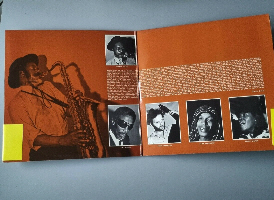 |
|||||||||||||||||||||||||||||||||||||||||||||
|
Sleevenotes to Albert Ayler - ‘Nuits de la Fondation Maeght’ Volume 1 (SH 83503) Original French version: Albert Ayler est né à Cleveland (Ohio) en 1936. Jouant d’abord du saxophone alto, il fait partie en 1952 de l’orchestre du chanteur et hamroniciste de blues Little Walter. Il choisit le saxo ténor quelques années plus tard et rencontre Cecil Taylor qu’il suivra en Scandinavie en 1962. L’année suivante, il dirige un trio qui comprend le bassiste Gary Peacock et le drummer Sunny Murray. Avec ce groupe auquel se joint le trompettiste Don Cherry, il effectue une tournée au Danemark, en Suède et en Hollande. En 1965, il se produit à Town Hall avec son frère, le trompettiste Don Ayler, l’altiste Charles Tyler, le bassiste Lewis Worrell et Sunny Murray. L’apparition d’Albert Ayler sur la scène du jazz, a provoqué bien des passions maid aussi bien des colères at des sarcasmes. Son premier passage à Paris, en 1966, à la fin d’un programme sensé retracer l’histoire du jazz, déclencha un scandale et suscita maintes polémiques. Un tel accueil eut pour effet de rendre pendant longtemps inconcevable un éventuel retour d’Albert Ayler dans notre pays jusqu’au jour ou fut annoncée sa participation aux Nuits de la Fondation Maeght 1970. Il vint à Saint-Paul de Vence, accompagné du pianiste Call Cobbs, du bassiste Steve Tintweiss, du drummer Allen Blairman et de la chanteuse Mary Maria, et ce fut le choc. Rappelé six fois, huit fois, dix fois, il recueillit le premier grand triomphe de sa carrière. On pourrait s’étonner que celui qui était considéré auparavavant comme le champion de l’anti-jazz soit aujourd’hui promu au rang des créateurs dont l’art est le plus enraciné. C’est que l’originalité de la démarche d’Ayler est justement d’allier simultanément le fondement même de la musique négro-américaine (le “swing”, le climat des spirituals ou des blues, par exemple) aux virtualités de cette musique, fussent-elles les plus vertigineuses, les plus “déraisonnables” ... Il est certain qu’à la première écoute, les émissions simultanées de plusieurs notes, le vibrato de très large amplitude, les grincements, sifflements et autres effets peuvent surprendre. Autre sujet possible d’étonnement: le contraste entre les improvisations et les thèmes qui leur servent de base. Ces derniers peuvent être des marches, des airs de fanfare ou de candides ritournelles. Naïveté apparente qui ne doit cependant pas faire illusion car Albert Ayler “vampirise” littéralement tout ce qu’il joue en un perfide détournement de sens grâce à l’outrance d’un expressionnisme qui masque, en les rendant d’autant plus agissants, de subtils décalages rythmiques et mélodiques. Contrairement à une idée trop répandue, ce qui nous frappe chez Ayler c’est que, malgré la grande spontanéïté qui préside de toute évidence à l’agencement des pièces qu’il crée, chacune se présente finalement le plus souvent sous la forme d’un “tout” parfaitement articulé, cohérent et définitif. Albert Ayler se meut dans l’univers musical qu’il est convenu d’appeler “New Thing” avec autant de naturel et d’aisance que Charlie Parker dans celui du be-bop. C’est au niveau d’un foisonnement de fulgurances indicibles qu’il nous parait convenir d’aborder en premier lieu son apport. Sur ce plan, hormis Louis Armstrong et Charlie Parker, nul improvisateur de jazz ne peut, à notre avis, lui être comparé. Daniel CAUX. * English Translation (courtesy of Richard Leigh): Albert Ayler was born in Cleveland, Ohio in 1936. In 1952, on alto saxophone, he joined the band of blues singer and harmonica-player Little Walter. A few years later he switched to tenor, and met Cecil Taylor, who had preceded him to Scandinavia, in 1962. In the following year he formed a trio with Gary Peacock on bass and Sunny Murray on drums. With this group, plus Don Cherry on trumpet, he toured Denmark, Sweden and Holland. In 1963 he played at Town Hall with his brother, trumpeter Don Ayler, altoist Charles Tyler, bassist Lewis Worrell and Sunny Murray. The arrival of Albert Ayler on the jazz scene has provoked great enthusiasm but also great rage and sarcasm. His first journey to Paris, in 1966, as the final act in a programme which aimed to trace the history of jazz, unleashed a scandal gave rise to a great deal of controversy. Such a reception had the effect of making his eventual return to this country unlikely for a long time to come, until the announcement of his participation in the Nuits de la Fondation Maeght in 1970. He came to St-Paul de Vence, with pianist Call Cobbs, bassist Steve Tintweiss, drummer Allen Blairman and singer Mary Maria, and made a huge impact. He was called back on stage for encores six times, eight times, ten times, and it was the first great triumph in his career. It might seem astonishing, that someone previously regarded as the champion of anti-jazz is now promoted to the rank of an innovator whose art is the most deeply rooted. The reason is that Ayler’s stance is precisely to wed the very foundations of Negro-American music (“swing”, the atmosphere of spirituals or blues, for example) to the strengths of this music, even the most vertiginous, the most “irrational”… Certainly at first hearing, the multiphonics, the huge vibrato, the growling, the wheezing and other effects can take the listener aback. Something else which can cause amazement is the contrast between the improvisation and the themes on which it is based.. These can be marches, fanfares or blatant repetition. This apparent naivete should not, however, mislead anyone, since Albert Ayler “vampirises” everything he plays in a treacherous derailing of the senses, thanks to the extremity of an expressiveness which masks subtle rhythmic and melodic displacements, while making them more effective. Contrary to popular belief, what is most striking about Ayler is that in spite of the great spontaneity which, according to all the evidence, characterises the arrangements of the pieces he creates, almost all of them appears as a perfectly articulated, coherent and definitive ”whole”. Albert Ayler finds himself in a musical universe which it is customary to call the “New Thing” just as it was natural for Charlie Parker to find himself categorised as be-bop. It seems to us that his contribution has to be acknowledged like an outpouring of indescribable lightning.. On this basis, no jazz improviser apart from Louis Armstrong and Charlie Parker can be compared to him. Daniel CAUX |
|||||||||||||||||||||||||||||||||||||||||||||||
 |
 |
 |
|||||||||||||||||||||||||||||||||||||||||||||
 |
|||||||||||||||||||||||||||||||||||||||||||||||
|
Sleevenotes to Albert Ayler - ‘Nuits de la Fondation Maeght’ Volume 2 (SH 83504) Original French version: A la fin de l'année 1970, celui qui était considéré pae ses admirateurs comme la plus forte personnalité du free jazz mourait dans des circonstances mystérieuses. Albert Ayler avait disparu du domicile new yorkais depuis le 5 novembre et c’est seulement trois semaines plus tard que l’on retrouvait son corps dans l’East River. Ses obsèques eurent lieu discrètement à Cleveland, sa ville natale, en présence des membres de sa famille et de quelques amis. Il avait trente-quatre ans. LeRoi Jones disait il y a quelques années: “Albert Ayler est un maitre aux dimensions stupéfiantes et il est irritant de penser que bien des gens pourraient mettre longtemps à s’en apercevoir”. De fait pendant de longues années, nous fumes peu nombreux à nous rendre compte de l’importance de ce novateur exceptionnel, qui était plutot considéré, comme un musicien bizarre à écouter par curiosité, voire comme un scandaleux imposteur? Pourtant, on peut se demander s’il a existé dans le jazz, un artiste encore plus profondément sincère qu’ Albert Ayler. Il est vrai que ce qu’il jouait présentait la rare particularité d’être à la fois très simple et très subtilement complexe, ce qui pouvait déconcerter les auditeurs car cela les obligeait à remettre en question leurs critères habituels. La musique d’Albert Ayler était aussi éloignée du ghetto intellectuel dans lequel on a pendant un temps essayé d’enfermer le free jazz que du rôle de divertissement sans conséquence auquel on a voulu ensuite la réduire afin d’en amoindrir la portée en feignant d’ignorer ses aspects les plus ‘dérangeants’. Simplicité ne veut pas dire simpliste et nulle démagogie n’entrait dans les propos d’Albert Ayler quand il parlait d’une musique du peuple pour le peuple. Il était parfaitemet lucide quant à ses objectifs: ”Je veux jouer les airs que je chantais quand j’étais enfant. Des mélodies folkloriques que tout le monde pourrait comprendre. J’utiliserais ces mélodies comme point de départ et plusieurs mélodies simples se déplaceraient à l’intérieur du même morceau. D’une simple mélodie à des textures complexes, puis de nouveau à la simplicité et de là, jusqu’aux sons les plus complexes, les plus denses.” On a voulu voir dans l’allégresse triomphante qu’exprime généralement la musique d’Albert Ayler et dans l’humour au second degré dont elle témoigne souvent, une volonté de destruction par la dérision, ce qui nous parait sujet à caution et, de toutes façons, singulièrement limitatif. Albert Ayler a déclaré à maintes reprises que ce qu’il jouait était essentiellement un chant, un cri d’amour et on peut le croire sur parole. Un amour universel exprimé avec une conviction presque effrayante et qui concilierait en un meme élan les multiples contradictions qui déchirent habituellement l’etre humain.Amour c’est à dire joie, bonheur suprème, mais aussi inévitablement bonheur menacé. D’où sans doute cette émotion ineffable jamais absente de sa musique qui constitue à nos yeux, un des éléments les plus profondément spécifiques. Le disque que nous vous présentons regroupe sur une face le début et sur l’autre les deux derniers morceaux du second concert donné par Albert Ayler à la Fondation Maeght. Joué avec ferveur, “Truth Is Marching in” n’est pas sans évoquer les enterrements à la Nouvelle Orléans et l’on sait qu’il fut joué par Albert Ayler aux obsèques de John Coltrane. Un haut niveau d’intensité expressive sera maintenu tout au long du concert. On remarquera les interventions du pianiste Cal Cobbs qui fut autrefois un des accompagnateurs de Billie Holiday et dont le jeu poétique convient particulièrement à celui d’Ayler. Pris sur un tempo très lent, “Music is the healing force of the Universe” qui fut le dernier morceau joué par Albert Ayler à Saint-Paul de Vence semble marquer une volonté de retenir l’écoulement du temps. Mary Maria chante avec “soul” tandis qu’Albert Ayler l’accompagne par contrechants d’un lyrisme dramatique qui ne peuvent manquer d’éveiller aujourd’hui de singulières résonances. Daniel CAUX * English Translation (courtesy of Guy Kopelowicz): By the end of the year 1970, the musician who was thought of as being the strongest personality of the free jazz died in mysterious circumstances. Albert Ayler had disappeared from his New York City home since November 6. His body was found in the East River three weeks later. His funeral was held discreetly on December 4 in his native Cleveland. Members of his family and several friends attended the funeral. He was 34. After having scored his first major triumph at the Nights of the Maeght Foundation, he was scheduled to come back to France at the start of 1971 and was eagerly expected there. LeRoi Jones said several years ago “Albert Ayler is a master of stupefying dimensions and it is frustrating to think that many people might take a long time to be aware of it”. As a matter of fact, there were few of us to acknowledge the importance of this exceptional innovator who was thought of as being a weird musician, one that would be listened to out of curiosity or as a scandalous impostor. However one can wonder if there has ever been a purer and more sincere artist in the jazz field than Albert Ayler. It is true that what he played was both very simple and also very subtly complex, a situation that puzzled listeners who had to revise their usual criteria. The music of Albert Ayler was as distanced from the intellectual ghetto in which for a time free jazz was confined as from the entertaining without consequences it was later reduced to so as to lessen its impact while ignoring its most radical aspects. Simplicity does not mean simplism and there was no demagogy in the words of Albert Ayler when he spoke of a music from the people for the people. He was perfectly aware of its objectives: “I want to play the melodies I sang when I was a kid. Folk melodies that every one could understand. I would use these melodies as starting points and several simple melodies that move inside the same tune. From a simple melody to complex textures, then back to simplicity and the more complex sounds and more dense ones.” People tended to see in the triumphant joy that is expressed in the music of Albert Ayler and in its ironic humour a will leaning on destruction through derision, an idea that is alien to us and one that would be at the very least too limitative. Albert Ayler stated on several occasions that what he was playing was essentially a love cry and that can be taken for granted. A universal love that is expressed with a frightening conviction and one that would attach in a single swoop the numerous contradictions that usually tear the human. Love meaning joy, supreme happiness but also happiness in danger. Out of this probably comes the ineffable emotion that is never absent from his music and which constitutes one of its specific elements. The album we present gathers on one side the start and on the other one the last two numbers from the second concert given by Albert Ayler at the Maeght Foundation. A fervour-laden “Truth is marching in” reminds one of the New Orleans funerals and we know it was played by Ayler at the funeral of John Coltrane. A high level of expressive intensity was to be maintained during the concert. One notes the interventions of pianist Cal Cobbs who was once one of Billie Holiday’s accompanists and whose poetic playing matches happily Ayler’s. Taken at a very slow tempo “Music is the healing force of the Universe” which was the last tune played by Albert Ayler at Saint Paul de Vence seems to mark a will to retain the passing of time. Mary Maria sings with ‘soul’ while Albert Ayler accompanies her with countermelodies of dramatic lyricism that can only raise singular resonances today. Daniel CAUX |
|||||||||||||||||||||||||||||||||||||||||||||||
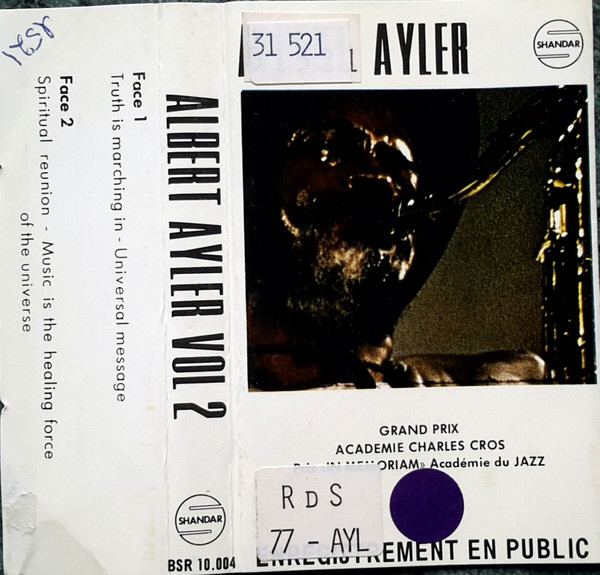 |
|||||||||||||||||||||||||||||||||||||||||||||||
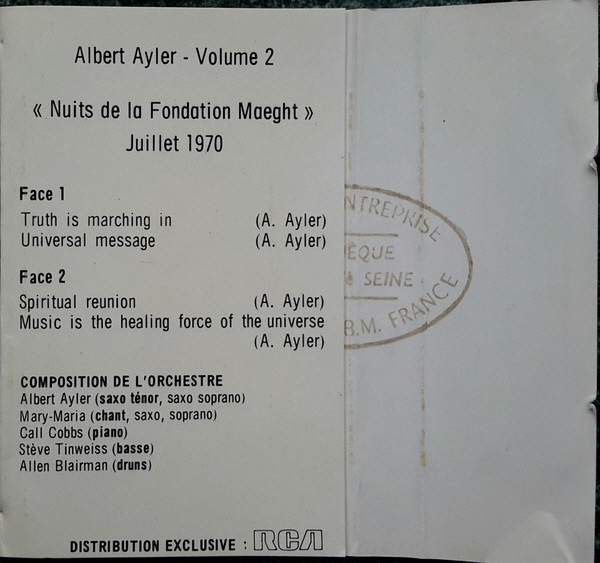 |
|||||||||||||||||||||||||||||||||||||||||||||||
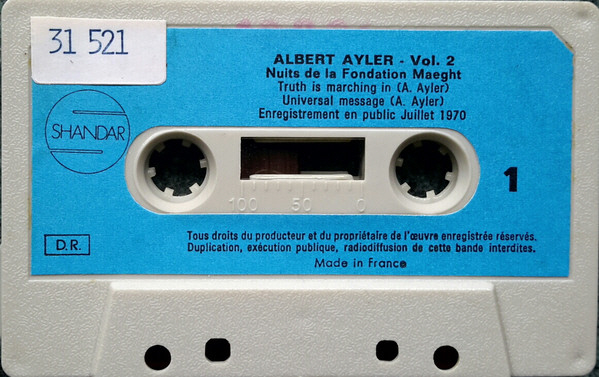 |
|||||||||||||||||||||||||||||||||||||||||||||||
|
Shandar 83503/83504 (Double LP) [Click images for full versions,] |
|||||||||||||||||||||||||||||||||||||||||||||||
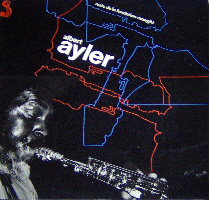 |
 |
||||||||||||||||||||||||||||||||||||||||||||||
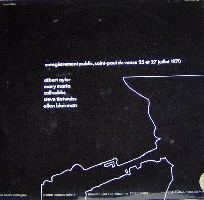 |
 |
 |
|||||||||||||||||||||||||||||||||||||||||||||
 |
 |
||||||||||||||||||||||||||||||||||||||||||||||
|
Sleevenotes to Albert Ayler - ‘Nuits de la Fondation Maeght’ Double LP Set (SH 83503/83504) (The sleevenotes of the double LP set are in French and English and these are given verbatim.) A la fin de l’année 1970, quelques mois seulement après avoir remporté un triomphe aux Nuits de la Fondation Maeght, mourait dans des circonstances mystérieuses celui que chacun s’accorde à considérer aujourd’hui comme la plus forte personnalité du jazz “free”. Albert Ayler avait disparu de son domicile new-yorkais le 5 novembre, et ce n’est que trois semaines plus tard que l’on retrouvait son corps dans les eaux de l’East River. Ses obsèques eurent lieu à Cleveland, so ville natale. Il avait trente-quatre ans. Le Roi Jones écrivait en 1965: “Albert Ayler est un mâitre aux dimensions stupéfiantes, et il est irritant de penser que bien des gens pourraient mettre longtemps à s’en apercevoir.” De fait, pendant de longues années, peu nombreux furent ceux qui se rendirent compte de l’importance de ce novateur exceptionnel. A cette époque, Albert Ayler était plutôt considéré comme un musicien bizarre à écouter seulement par curiosité, voire comme un scandaleux imposteur. On peut s’étonner que celui qui a fait pendant longtemps figure de champion de l’anti-jazz soit aujourd’hui promu au rang des créateurs dont l’art est le plus solidement enraciné. C’est que l’originalité de la démarche d’Albert Ayler est d’allier les fondements mêmes de la musique afro-américaine — le “swing”, le climat du blues, du spiritual et de traditions peut- être encore plus anciennes — à ses virtualités les plus extrêmes, les plus vertigineuses, les plus “déraisonnables”... Il est certain qu’à la première écoute, les émissions simultanées de plusieurs notes, le vibrato de large amplitude, les grincements, sifflements d’anche et autres effets qu’il peut employer ont de quoi surprendre. Autre sujet possible d’étonnement: les thèmes qui servent de prétexte ou de base aux improvisations. Ces derniers peuvent être des marches, des airs de fanfare ou de candides ritournelles. Une naïveté apparente qui ne doit pas pour autant faire illusion car Albert Ayler “vampirise” littéralement tout ce qu’il joue, et cela grâce à l’outrance d’un expressionnisme qui masque, en les rendant d’autant plus agissants, de subtils décalages rythmiques et mélodiques. Albert Ayler était parfaitement lucide quant à ses objectifs, et nulle démagogie n’entrait dans ses propos quand il parlait d’une musique du peuple pour le peuple: “Je veux jouer les airs que je chantais quand j’étais enfant. Des mélodies folkloriques que tout le monde pourrait comprendre. J’utiliserais ces mélodies comme point de départ et plusieurs mélodies simples se déplaceraient à l’intérieur d’un même morceau. D’une simple mélodie à des textures complexes, puis de nouveau à la simplicité et, de là, jusqu’aux sons les plus complexes et les plus denses”. On a voulu voir dans l’allégresse triomphante qu’exprime souvent la musique d’Albert Ayler, et dans l’humour dont elle témoigne parfois, une volonté de destruction par la dérision, ce qui nous a toujours paru sujet à caution et, de toutes façons, par trop limitatif. Albert Ayler a déclaré à plusieurs reprises que ce qu’il jouait était essentiellement un chant, un cri d’amour et on peut le croire sur parole. Un amour universel exprimé avec une conviction presque effrayante. Amour c’est-à-dire joie, bonheur suprême, mais aussi, inévitablement, bonheur menacé. D’où, sans doute, cette émotion poignante qui n’est jamais absente de sa musique et qui en constitue même, à nos yeux, un des éléments les plus profondément spécifiques. De quelle façon aurait évolué la musique d’Albert Ayler s’il avait survécu? A côté de la fougue et de l’exubérance coutumières, apparaît dans les enregistrements de la Fondation Maeght une inclination vers un dépouillement auquel le saxophoniste ne nous avait pas habitués. “Music is the Healing Force of the Universe”, le dernier morceau joué à Saint Paul de Vence, semble marquer une volonté de retenir l’écoulement du temps. Mary Maria y chant avec “soul”, tandis qu’Albert Ayler l’accompagne par des contre-chants dont le lyrisme déchirant ne peut manquer d’éveiller aujourd’hui de singulières résonances. Daniel CAUX
Towards the end of 1970, shortly after a triumphant success at the “Nights of the Maeght Foundation”, he died in mysterious circumstances; the man is considered today by most people as one of the best exponents of “free” jazz. Albert AYLER had vanished from his New York home on November 5, 1970. Three weeks later, his body was found in the East River. His burial took place in Cleveland, his home town. He was thirty years old. In 1965, le Roi Jones wrote: “Albert AYLER is a master of staggering dimension, now, and it disturb me to think that is might take a long time for a lot people to find it out”. Thus during a long time, there were few who were aware of the importance of this exceptional innovator. At that time, Ayler was considered a musical oddity, to be listened to only out of curiosity; or even as a scandalous imposter. It is surprising to note that he, who was for a long time the representative of an anti-jazz movement ranks today as one of its foremost creators, whose art has deep roots. The originality of Albert Ayler’s music is to merge the very foundation of Afro-american music, of swing, of the climate of the blues, of spirituals and perhaps even older traditions—with its most extreme, unreasonable virtualities... Certainly when heard for the first time, the simultaneous emission of several notes the large range of the vibrato, the grating sounds, the whistling of the reeds and the other effects that he might use, are subject of surprise. Another subject of surprise: the themes which are used as a pretext or base for the improvisations. These include marches, parade music or candid ritornelles. This apparent naivety should not deceive the listener, for Albert Ayler literally “vampirizes” everything he plays, thanks to the exaggerations of his expressionism which conceal, in order to make them more effective, subtle rhythmic and melodic differences. Albert Ayler knew precisely what he was aiming at and there was not the slightest hint of demagogy in his idea of a music for the people and by the people. “I want to play the tunes that I used to sing when I was a kid. Folk music that anybody can understand. Within the same number, I would use these melodies as starting points that would be put together with several other simple ones. There would be a progression from a simple melody to more elaborate ones, then a return to simplicity and from there, I would reach more complex and dense sounds.” The extreme joyfulness and humor of Albert Ayler’s music has been sometimes considered as aimed towards destruction, an analysis we never agreed with and which, anyway, we considered too narrow an approach. Several times, Albert Ayler described his music as being essentially a melody, an outburst of love, and one can believe him. It is universal love expressed sometimes with frightening strenght. By love we mean joy, and extreme, but also fragile happiness. This is perhaps the reason why this thrilling emotion is always there, giving to his music what we consider its most peculiar characteristic. What would have become of Albert Ayler’s music had he survived? In the Maeght Foundation’s recordings, one finds besides the saxophonist’s usual fire and exuberence, an element of simplicity to which his audience was not accustomed. In “Music is the Healing Force of the Universe”, the last piece he played in Saint Paul de Vence, he clearly seems to be trying to hold back time. Mary Maria sings with a lot of soul while Albert Ayler accompanies her with a poignant countrapuntal lyricism which would today no doubt strike deep chords.
|
|||||||||||||||||||||||||||||||||||||||||||||||
 |
|||||||||||||||||||||||||||||||||||||||||||||||
|
Jazz View 005 |
|||||||||||||||||||||||||||||||||||||||||||||||
 |
|||||||||||||||||||||||||||||||||||||||||||||||
 |
|||||||||||||||||||||||||||||||||||||||||||||||
 |
 |
||||||||||||||||||||||||||||||||||||||||||||||
 |
 |
||||||||||||||||||||||||||||||||||||||||||||||
 |
 |
||||||||||||||||||||||||||||||||||||||||||||||
 |
|||||||||||||||||||||||||||||||||||||||||||||||
 |
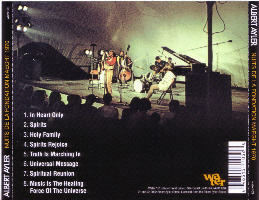 |
||||||||||||||||||||||||||||||||||||||||||||||
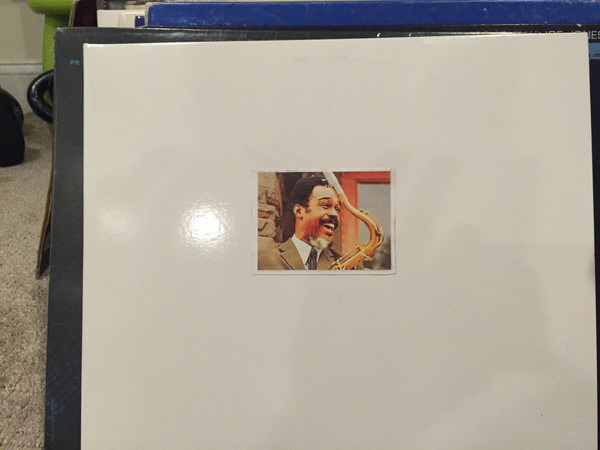 |
|||||||||||||||||||||||||||||||||||||||||||||||
 |
|||||||||||||||||||||||||||||||||||||||||||||||
 |
|||||||||||||||||||||||||||||||||||||||||||||||
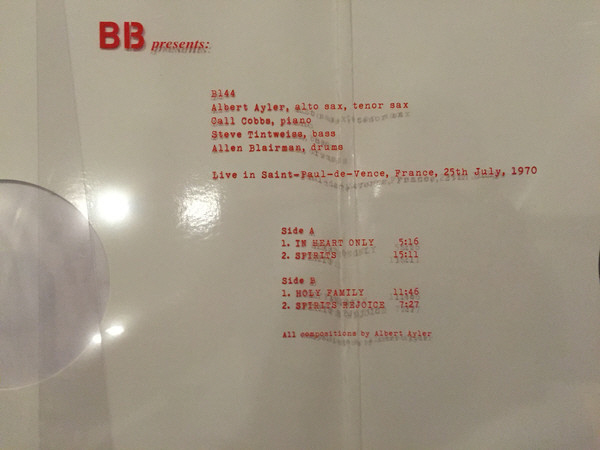 |
|||||||||||||||||||||||||||||||||||||||||||||||
 |
|||||||||||||||||||||||||||||||||||||||||||||||
|
Back to Nuits De La Fondation Maeght
|
|||||||||||||||||||||||||||||||||||||||||||||||
|
Home Biography Discography The Music Archives Links What’s New Site Search
|
